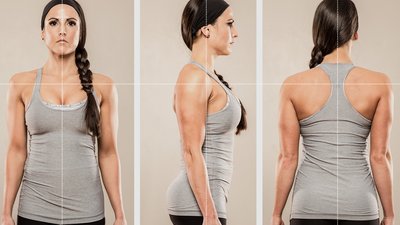Your posture says a lot about your personality. It also says a lot about how your joints and muscles are working. Here's everything you need to know about assessing your postural deviations and how to fix them!
Imagine a strong, powerful, confident person standing in front of you. What kind of posture does that person have? Undoubtedly, the person in front of you is standing tall with an open chest and a head held high. It's a person who looks ready to take on the world.
How you look and feel is directly related to your posture. Despite the importance of having good posture, most of us don't do anything to improve it. We go about our lives with hunched backs and imbalanced hips, and deal with pain because we think it's normal.
Living with bad posture can be a dangerous thing. The muscle and ligament imbalances that result from poor alignment can lead to all sorts of problems:
- Chronic back, neck, and shoulder pain
- Foot, knee, hip, and back injuries
- Headaches
- Stiffness
- Fatigue
- Muscle atrophy and weakness
- Difficulty breathing
- Digestion issues
- Impingement and nerve compression
- Sciatica
- Carpal tunnel syndrome
But we're going to fix that right now! By understanding proper posture, you can learn about your own postural deviations and determine which corrective exercises will work best to improve your alignment. With correct alignment and good posture, your lifts will be stronger, your muscles will work more efficiently, you'll help prevent pain and injury, and you'll look and feel a heck of a lot better.[1-3]
Correcting Your Alignment
To solve a problem, you first need to pinpoint the cause. Most postural deviations occur because the muscles that work to hold a joint in place are imbalanced. Generally speaking, one muscle group will be too tight and the opposing muscle group will be too loose or weak.
For example, those with shoulders that hunch forward too far often have tight pec muscles that pull the shoulders forward and rotate them in toward the midline of the body. Pair tight pecs with weak back muscles and you have an imbalance that pulls the shoulder girdle away from its ideal position. When imbalances like these occur, overactive muscles compensate for underactive muscles, which causes tension, fatigue, and discomfort.
The easiest and most effective way to correct imbalances is to stretch the overactive muscles and to strengthen the underactive muscles.
Standing Assessment
If you haven't been paying attention to your posture, it's probably a given that you have no idea how misaligned your body might be. If you're not sure whether your posture is good or if it needs a little work, do this standing assessment first:
Put on form-fitting clothes so you can see your alignment. Stand barefoot, tall but comfortable, without trying to force yourself into what you think is perfect posture. To get an honest assessment, close your eyes and march slowly in place a few times. This will allow your feet to turn in and out naturally. Bring your body to a stop and stand still. Have a friend take a full body picture of you from the front, the side, and behind.
Here's what a properly postured body should look like:
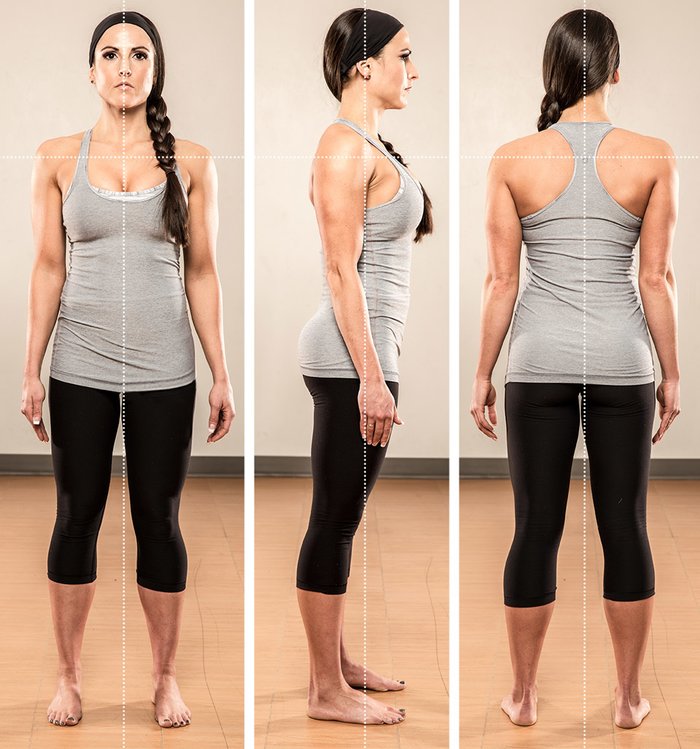
Notice that, in this photo, the joints are stacked. The ears are over the shoulders, the ribs over the hips, and the hips over the heels. The pelvis and spine are in a neutral position. If this is what your body looks like, you're doing well!
Standing Assessment Postural Deviations
Back, Shoulders, Hips, And Head
If your body doesn't look aligned, you might have one or more of the following postural deviations. Here's how to spot these deviations and the stretches and strengthening exercises you can do to fix them.
Deviation 1: Sway Back
Hips Press Forward And Sit In Front Of The Ribs
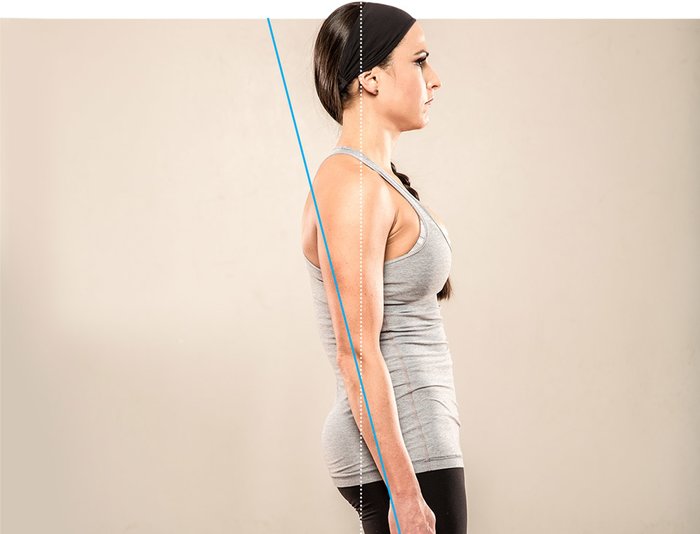
Overactive muscles: Hamstrings, gluteus maximus and medius, erector spinae, and quadratus lumborum (glutes, hamstrings, and low back)
Stretches: Runner's stretch, world's greatest stretch, seated glute stretch, lying crossover, hamstring stretch, hamstring self-myofascial release (foam rolling)
Underactive muscles: Iliopsoas, external obliques, and rectus femoris (hip flexors and lower abs)
Strengthening exercises: Cocoon, exercise ball pull-in, hanging leg raise, scissor kick
Deviation 2: Lower-Cross Syndrome
Excessive Curve In The Low Back, Pelvis Is Tilted Forward
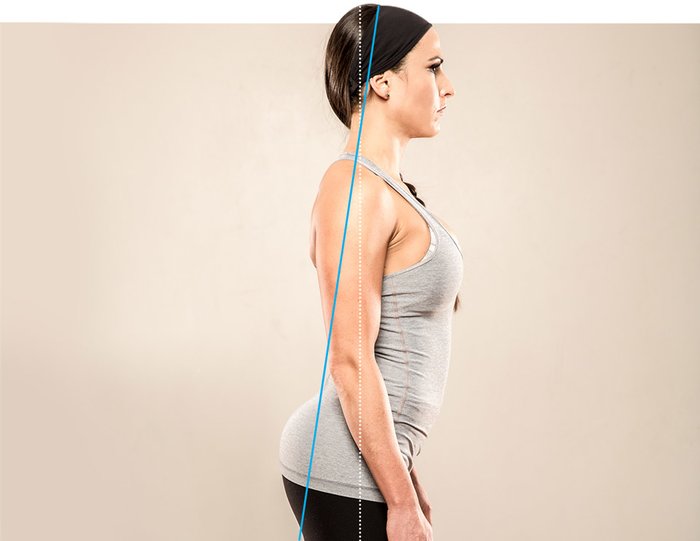
Overactive muscles: Iliopsoas and erector spinae (hip flexors and low back)
Stretches: Pyramid stretch over ball, kneeling hip flexor, quadriceps stretch, quadriceps self-myofascial release, hug knees to chest
Underactive muscles: Abdominals and gluteus maximus
Strengthening exercises: Pelvic tilt to bridge, single-leg glute bridge, exercise-ball hip bridge, leg-elevated crunch, frog sit-up
Deviation 3: Rounded Shoulders
Shoulders In Front Of Ears
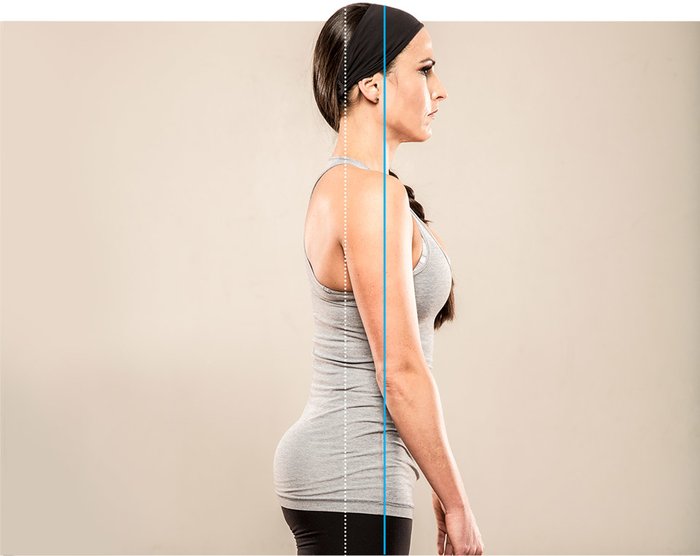
Overactive muscles: Pectoralis major and minor (chest)
Stretches: Front deltoid stretch, elbows-back stretch, chest stretch on stability ball, dynamic chest stretch, chair upper-body stretch
Underactive muscles: Rotator cuff, lower trapezius, serratus anterior (muscles in the back surrounding the shoulder blades and rear delts)
Strengthening exercises: Seated cable row, back fly with band, shoulder external rotation, rear- delt row
Deviation 4: Forward Head
Ears In Front Of Shoulders
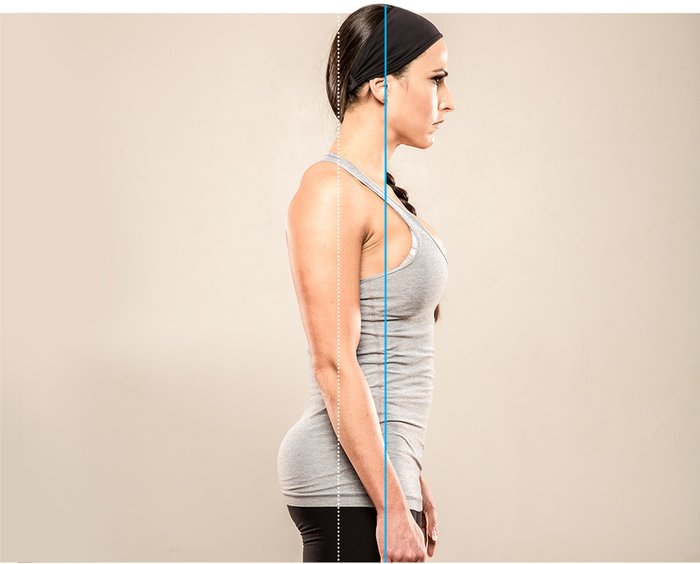
Overactive muscles: Neck extensors, upper trapezius, and levator scapula (muscles behind the neck that tilt the head back)
Stretches: Neck self-myofascial release, chin to chest, sternocleidomastoid stretch (with palms up, reach your arms as far back as possible while turning your head to look to one side)
Underactive muscles: Neck flexors (muscles in front of the neck that tilt the head forward)
Strengthening exercises: Isometric front-neck exercise
Deviation 5: Upper-Cross Syndrome
Rounded Shoulders With An Excessive Curve
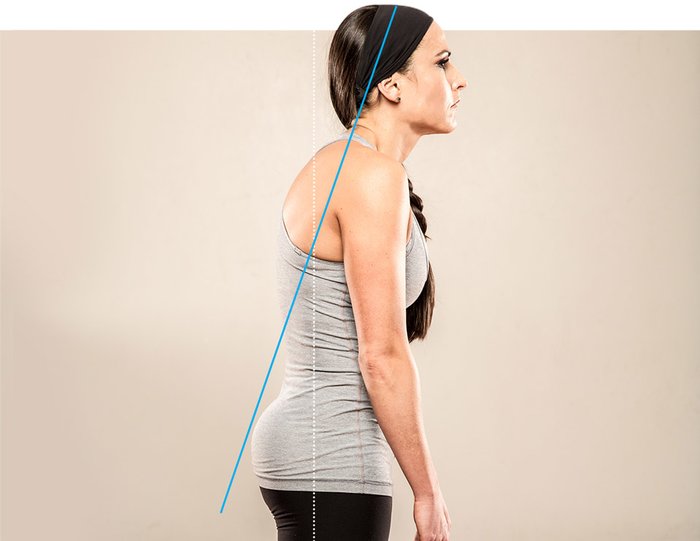
Overactive muscles: Trapezius, levator scapula, pectoralis major and minor, neck extensors (the back of your neck, traps, upper back, and chest)
Stretches: Neck self-myofascial release, chin to chest, front-delt stretch, elbows-back stretch, chest stretch on stability ball, dynamic chest stretch, chair upper-body stretch
Underactive muscles: Rotator cuff, lower trapezius, rhomboids, serratus anterior, and deep neck flexors (muscles in the back surrounding the shoulder blades, rear delts, and in front of the neck)
Strengthening exercises: Isometric front-neck exercise, seated cable row, back fly with band, shoulder external rotation, rear-delt row
Deviation 6: Head Tilt
Head Tilted To One Side; Can Be Accompanied By Rotation Toward That Side
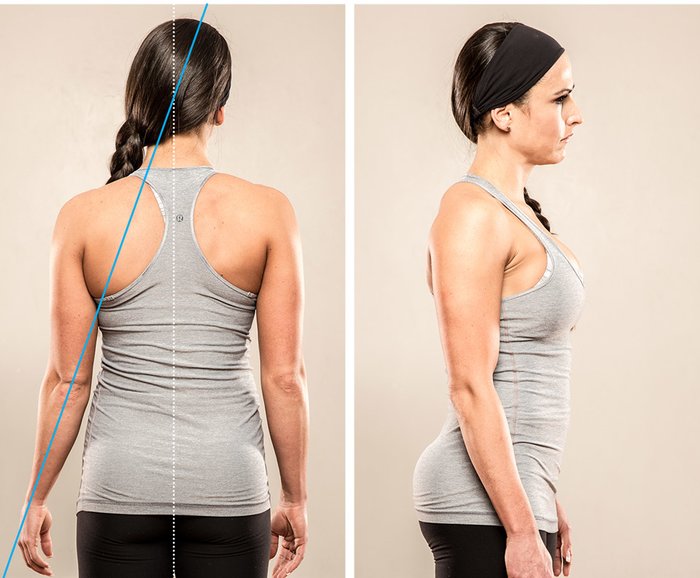
Overactive muscles: Sternocleidomastoid tilted toward midline. (The sternocleidomastoid runs from behind the ear to the collar bone, works to flex the chin down, move your ear towards your shoulder, and to turn the head.)
Stretches: Side neck stretch, neck self-myofascial release, sternocleidomastoid stretch
Underactive muscles: Sternocleidomastoid tilted away from midline.
Strengthening exercises: Perform daily activities (e.g., chewing, carrying, pulling, lifting, and using a cell phone) evenly on both sides, isometric side-neck exercise
Deviation 7: Uneven Shoulders
One Shoulder Sits Higher Than The Other
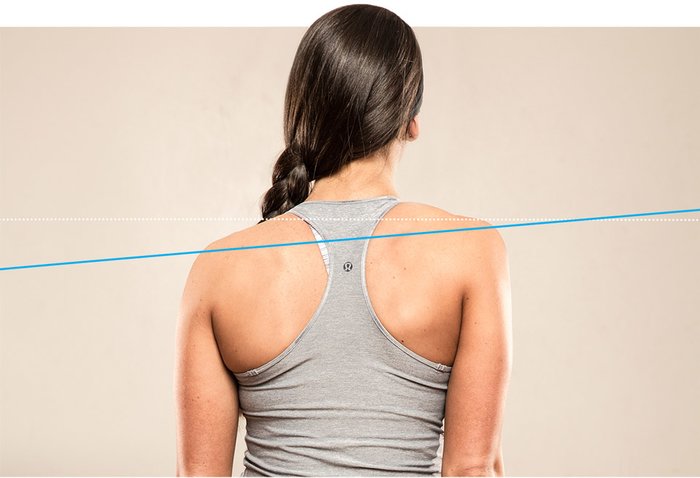
Overactive muscle: Trapezius (muscle running from the back of the neck into the shoulder girdle) on the elevated side
Stretches: Side neck stretch, neck self-myofascial release
Underactive muscles: Serratus anterior (muscle running from upper ribs to the shoulder blade under your pecs) on the elevated side
Strengthening exercises: Perform daily activity like carrying, chewing, pulling, lifting, using a cell phone evenly on both sides; single-arm high-pulley row
Deviation 8: Uneven Hips
One Hip Sits Higher, Can Give The Perception Of Leg Length Discrepancy
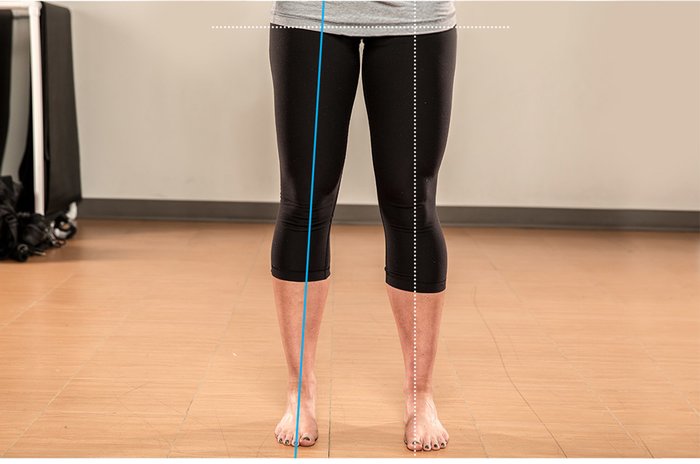
Overactive muscles: Internal and external obliques, hip abductors, erector spinae and quadratus lumborum on the raised side (muscles along the side of waist and outer hip, low back, and the hip.). Many other tissues in the knee, ankle, shoulder girdle, neck, and low back may also be overactive.
Stretches: Runner's stretch, world's greatest stretch, IT-band stretch, IT-band self-myofascial release, seated glute stretch, lying cross-over, piriformis self-myofascial release, dancer's stretch
Underactive muscles: Varies based on individual
Strengthening exercises: Avoid high-impact and high-repetition exercises (running, plyometrics, etc.) until the pelvis is aligned. This will reduce the risk of secondary injuries in the ankle, knees, hips, and low back.
Standing Assessment Postural Deviations
Feet And Ankles

Like your shoulders, hips, and back, your feet and ankles have a proper alignment. Properly aligned feet and ankles should face forward, rather than turn inward or outward.
Here are some common postural deviations for the feet and ankles. If you notice that you have one or more of these issues, try the stretches and strengthening exercises to alleviate issues.
Deviation 9: Feet Turned In
Toes Are Turned In Toward The Midline Of The Body

Overactive muscles: Tensor fasciae latae (outside of your hip)
Stretches: IT-band stretch, IT-band self-myofascial release
Underactive muscles: Gluteus medius and minimus
Strengthening exercises: Bridge with band tension around thighs, lateral tube walk, squat with band tension around thighs
Deviation 10: One Or Both Feet Turned Out
Toes Are Turned Out Away From The Midline Of The Body

Overactive muscles: Piriformis and the other deep external rotators (muscles really deep in your hip attaching the femur to your sacrum)
Stretches: Seated glute stretch, lying cross-over, piriformis self-myofascial release, IT-band stretch, IT-band self-myofascial release, dancer's stretch
Underactive muscles: Hip flexors and obliques
Strengthening exercises: Cocoon, exercise ball pull-in, hanging leg raise
Your Turn!
Now that you know what to look for, it's time to assess your own posture. If you notice any of these imbalances in your photos, utilize the stretches and strengthening exercises to correct them.
Implement the strengthening exercises into your regular routine as needed. For example, if you have upper-cross syndrome, do the strengthening exercises like rows and shoulder rotations on your back day. I suggest 3 sets of 8-12 reps.
Save static stretching for the end of your workout. Perform stretches so they produce a slight pull on the muscle, but are not painful. Hold each stretch for 15-30 seconds, and repeat a total of 3-5 sets.
Keep at it and soon you'll notice some excellent results: You'll feel better, look better, and lift heavier!
References
- Tips to Maintain Good Posture. Retrieved from http://www.acatoday.org/content_css.cfm?CID=3124
- Posture for a Healthy Back. Retrieved fromhttp://my.clevelandclinic.org/healthyliving/backhealth/hicpostureforahealthy_back.aspx
- Neck Pain: What You Can Do. Retrieved fromhttp://mydoctor.kaiserpermanente.org/ncal/Images/9134000104_tcm75-14582.pdf

